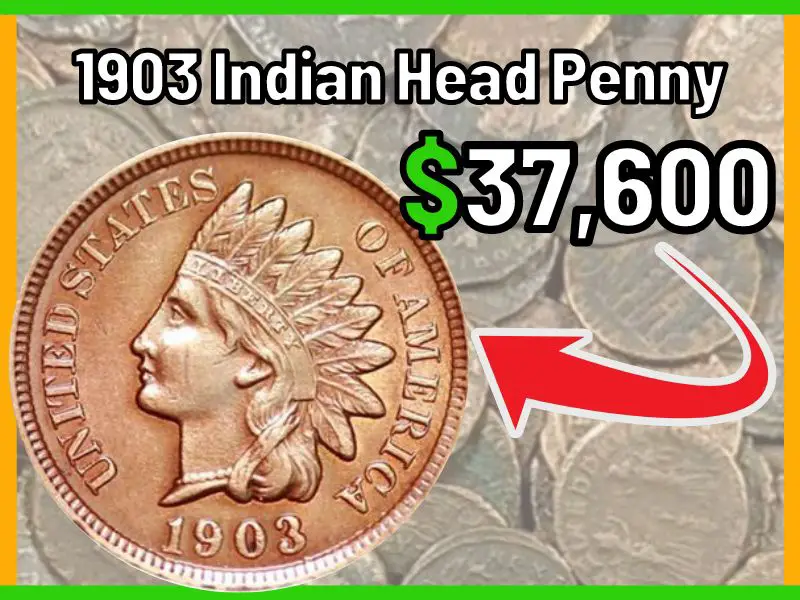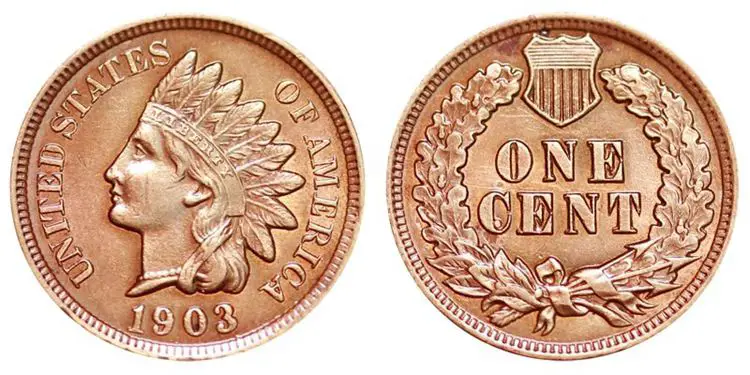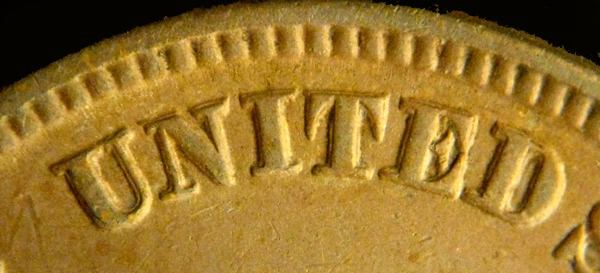
While an 1903 Indian Head Penny in average condition is valued at about $2.50, one in mint state could bring in as much as $5,460. The value of the coin depends on the condition, type of strike and color.
For many people, collecting pennies is a fun and interesting hobby. Indian head pennies are
especially popular among collectors, due to their unique history and design. These coins were first minted in 1859, and they continued to be produced until 1909. Because of their age and rarity, these coins can be quite valuable.
If you’re a collector of Indian Head Pennies, then today’s blog post is for you! In this post, we’ll take a look at the 1903 Indian Head Penny Value. As always, we’ll provide information on how to identify a genuine 1903 penny, as well as some insights on the coin’s value and history. So if you’re curious about what your 1903 penny is worth, keep reading!
Are Indian Head Pennies Worth Collecting?
The Indian Head Penny was first minted in 1859, and it quickly became a popular coin. Featuring the likeness of Lady Liberty wearing a Native American headdress, the Indian Head Penny was designed to reflect the nation’s growing western frontier. For many years, the Indian Head Penny was the smallest denomination of coin in circulation, and it remained in production until 1909.
Today, the Indian Head Penny is a popular collectible coin, and it can be worth a significant amount of money. While common date Indian Head Pennies are relatively affordable, rare varieties can fetch thousands of dollars at auction.
As a result, collectors often look for Indian Head Pennies that are in good condition and that have low mintages. Whether you’re just starting out or you’re a seasoned collector, the Indian Head Penny is definitely a coin worth considering.
1903 Indian Head Penny Identification Guide

Photo: usacoinbook
The 1903 Indian Head Penny is a popular coin among collectors. This coin is composed of 95% copper and 5% tin and zinc, and it has a diameter of 0.75 inches (19.05 mm). The coin’s thickness is 0.07677 inches (1.95 mm) and it weighs 0.10970 ounces (3.11 g). The edge of the coin is plain.
The coin was designed by James B. Longacre. Longacre was an American engraver and designer of coins and paper money. In 1844, Longacre was appointed chief engraver of the United States Mint. He would go on to design some of America’s most iconic coins, including the gold dollar, the three-cent piece, and the Indian Head penny.
Despite its name, the coin does not feature a Native American image on the obverse side. Instead, it features Liberty wearing a Native American headdress. The words UNITED STATES OF AMERICA and the date are also inscribed on the obverse side. The reverse side of the coin bears the denomination of ONE CENT in the center, surrounded by a wreath. A ribbon with arrows tied in at the bottom center also appears on the reverse side.
All 1903 pennies were minted in Philadelphia and do not have a mint mark.
Because copper is an active metal, the 1903 Indian Head Penny occurs in a few stunning multi-color varieties, including brown, red brown and red patina.

Photo: error-ref
Longacre Doubling is a type of doubling that is found on all of Longacre’s designs. It is most commonly found on Indian Head pennies, but can also be seen on other coins designed by Longacre. It is thought to be from the edges of the logo punches, and it’s very common. Because it is so common, it doesn’t usually add to the value of a coin. However, some collectors consider it to be a desirable feature, as it adds to the coin’s history and uniqueness.
Are 1903 Indian Head Pennies Rare?
The answer to the question “Are 1903 Indian Head Pennies Rare?” is both yes and no. While 1903 pennies are not particularly rare, they are much less common than other dates from the Indian Head Penny series. In 1903, the Philadelphia minted 85,092,703 business strike coins and 1,790 proof coins.
Type of strike |
Mintage |
1903 Indian head penny business strike |
85,092,703 |
1903 Indian head penny proof strike |
1,790 |
Despite their age, 1903 Indian Head Pennies are still relatively common and can often be found in circulated condition. However, examples in well-preserved condition are highly prized by collectors. Considering its age, design, and history, the 1903 Indian Head Penny is a truly unique coin.
How Much are 1903 Indian Head Pennies Worth?
1903 Indian Head pennies are worth anywhere from a few cents to several hundred dollars, depending on the coin’s condition and type of strike.
1903 Indian Head Penny Value
Type |
Good |
Fine |
Extremely fine |
Uncirculated |
1903 |
$2 |
$4.5 |
$10 |
$20 |
1903 Indian head penny price chart
According to JM Bullion, most circulated 1903 Indian Head Pennies are only worth between $2 and $10, uncirculated coins can be worth much more – up to $20!
1903 Indian Head Proof Penny Value
Grade |
1903 brown |
1903 red/brown |
1903 red |
PR 60 |
$143 to $172 |
$176 to $211 |
$260 to $299 |
PR 61 |
$162 to $195 |
$221 to $254 |
$292 to $336 |
PR 62 |
$188 to $226 |
$260 to $299 |
$325 to $374 |
PR 63 |
$221 to $254 |
$299 to $344 |
$364 to $419 |
PR 64 |
$292 to $336 |
$422 to $486 |
$585 to $673 |
PR 65 |
$422 to $486 |
$572 to $658 |
$1,150 to $1,290 |
PR 66 |
$910 to $1,090 |
$1,150 to $1,310 |
$1,750 to $2,010 |
PR 67 |
$3,440 to $4,060 |
$5,620 to $7,500 |
$4,750 to $5,460 |
1903 Indian head proof penny price chart
Proof coins are specially made for collectors and tend to be worth more than regular coins. The 1903 Indian Head proof penny is no exception. These pennies were minted in very limited quantities and, as a result, can be quite valuable today.
The value of a proof penny depends on its condition and color. Brown pennies in PR 60 condition can be worth $143, while red pennies in PR 67 condition can be worth $5,460. If you think you might have a 1903 Indian Head penny in your collection, consult the price chart above to get an estimate of its value.
How to Find the 1903 Indian Head Cent Value
1903 Indian Head cents are very popular among collectors, and they can be worth a pretty penny. But how do you know if your 1903 Indian Head cent is valuable? The first step is to compare it to recently sold 1903 Indian Head cents. Look at the pricing history to see what similar coins have sold for in the past. This will give you a good idea of the coin’s value.
Keep in mind, however, that the value of a coin can fluctuate over time, so it’s important to stay up-to-date on recent sales.
- A circulated 1903 Indian head cent sold for around $3.
- Uncirculated 1903 Indian head penny graded MS 62 sold for $37.
- Uncirculated 1903 Indian head proof penny sold for over $500.
- Uncirculated 1903 Indian head penny graded MS 63 RD by PCGS sold for $2,950.
You can also get an appraisal from a professional numismatist. They will be able to take a look at your coin and give you an expert opinion on its value. With a little research, you should be able to find out if your 1903 Indian Head cent is valuable.
What is the Most Expensive 1903 Indian Head Penny Ever Sold?
In 2017, an extremely rare 1903 Indian Head penny was sold at auction for an astounding $37,600. The coin, which was graded PR68 by PCGS, is one of only a handful of examples that exist in such pristine condition. Featuring a beautiful red patina, the coin is considered to be one of the most visually alluring examples of its type. It is also notable for its technical quality, as it features very few blemishes and appears to have been struck with great care. Consequently, it is not surprising that this 1903 Indian Head penny realized such a high price at auction.
In 2009, a 1903 S penny graded MS 67 by PCGS was sold for $37,375, making it the second most expensive 1903 Indian Head penny ever sold. The 1903 S penny is one of the rarest and most desirable Indian Head pennies, with only a handful of examples known to exist in high grades.
Coin Grading 101: How to Grade Your 1903 Indian Head Cents
Before a coin is graded, it goes through a process where its authenticity is verified, then it is cleaned and finally examined for any damage. After that, the coin is ready to be graded on a 70-point scale. The first step in grading a coin is to hold it up to a light to check for any obvious signs of counterfeiting, such as an incorrect metal content, off-centered striking, or raised lines that should not be there.
Next, the coin is checked for cleanliness; any dirt or debris on the surface will lower the grade. Once the coin has been verified as authentic and cleaned, an examiner will closely inspect it for any damage, such as scratches, nicks, or dents. Based on the condition of the coin, it will be assigned a grade from 1 to 70, with 70 being a perfect uncirculated coin.
Here is a list of common coin grades:
Proof-70 = Perfect Proof
Proof-65 = Choice Proof
Proof-60 = Proof
MS-70 = Perfect Uncirculated
MS-65 = Choice Uncirculated
MS-60 = Uncirculated
AU-55 = Choice About Uncirculated
AU-50 = About Uncirculated
EF-45 = Choice Extremely Fine
EF-40 = Extremely Fine
VF-30 = Choice Very Fine
VF-20 = Very Fine
F-12 = Fine
VG-8 = Very Good
G-4 = Good
AG-3 = About Good
Coins that are Graded higher are more valuable because they are more rare, so collectors are willing to pay more for them. However, the Grade of a coin can also be affected by factors such as supply and demand, so even a lower-graded coin can be worth more if there is high demand for it. In general, though, the higher the Grade of a coin, the more valuable it is.
Final Thoughts
The 1903 Indian Head Penny is a highly sought-after coin among collectors, and its value depends on a number of factors. The type of strike, for example, can significantly affect the value of the coin. A proof strike, which was made using a special minting process, is typically worth more than a standard circulation strike. The condition of the coin is also important: a coin that is in mint condition will be worth more than one that is heavily circulated. Finally, the color of the coin can also affect its value.
The 1903 Indian Head Penny is a very valuable coin, worth anywhere from $2.50 to $5,460. If you think you may have a rare and valuable 1903 Indian Head Penny, it is important to have it appraised by a professional numismatist to determine its value.
FAQ
Can I melt down pennies and sell the copper?
Yes, you can melt down pennies and sell the copper. All things considered, melting down your pennies for profit is probably not worth the risk or effort involved. But if you’re willing to take those risks, it is possible to make some money from your old coins!
What is Longacre doubling?
Longacre doubling is a phenomenon that affects coins designed by Longacre. It is thought to be caused by the edges of the logo punches used during production, which transfer extra metal to the coins as they are struck. As a result, the coins exhibit doubled features on their obverse and reverse sides.
What is a 1903 Indian head penny made of?
The 1903 Indian head penny is a small copper coin minted by the United States government in that year. It was made of an alloy of 95% copper and 5% tin and zinc, and it had a diameter of 19 mm.
